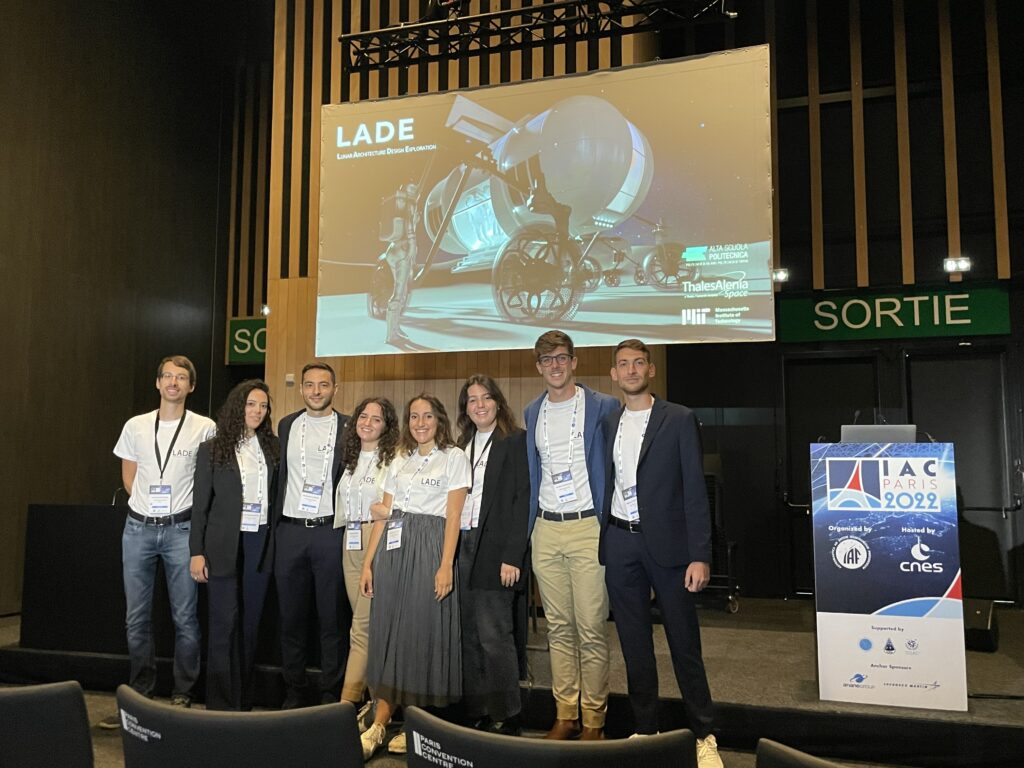
The ASP project L.A.D.E. – Lunar Architecture Design Exploration was recently showcased at the 73rd edition of the IAC, the International Astronautical Congress, hosted in Paris from the 18th to the 22nd of September 2022, where the results of the research and design work has been presented in an original scientific paper by the ASP students members of the team Ad Astra that developed the project.
Furthermore, a 3D printed mock-up of the module has been showcased by Thales Alenia Space, industrial partner of the project, at their conference stand.
The project was developed in cooperation with Thales Alenia Space and Massachusetts Institute of Technology to design the future of lunar exploration: a mobile space architecture system that will soon be on the lunar surface.
Thanks to this experience, the ASP students, have the chance to face fascinating challenges, outside their previous expertise and academic path, supported by their ASP Tutors, Prof. Valentina Sumini, Prof. Paolo Maggiore and Prof. Claudio Chesi, from Politecnico di Torino and Politecnico di Milano, and by their Thales Alenia Space tutors, Massimo Comparini and Enrico Ferrone.
The collaboration with the Massachusetts Institute of Technology made it possible for the students to have the L.A.D.E. project reviewed by the former astronaut Jeffrey Hoffman and Prof. Joseph Paradiso, who enriched the project with their experience.
Since the Apollo missions, exploration of deep space has seen decades of technological advancement and scientific discoveries. Today, over 50 years after the remarkable first Moon landing, NASA is envisioning a plan to drive humanity to live on the Moon. This new phase of Space Exploration is centered on the Artemis Program, gathering international efforts to achieve such ambitious goals. This would not be the first international collaboration in Space Exploration history, having the ISS as a brilliant example of this cooperation for over 20 years, representing the first extraterrestrial society.
In this framework, Alta Scuola Politecnica and Thales Alenia Space partnered in LADE project, to design a novel agile habitat through a holistic multidisciplinary approach to allow crewed surface exploration missions. The project goal is to design a habitable mobile module, which represents the key movable component in a complex system of shelters on the lunar surface.
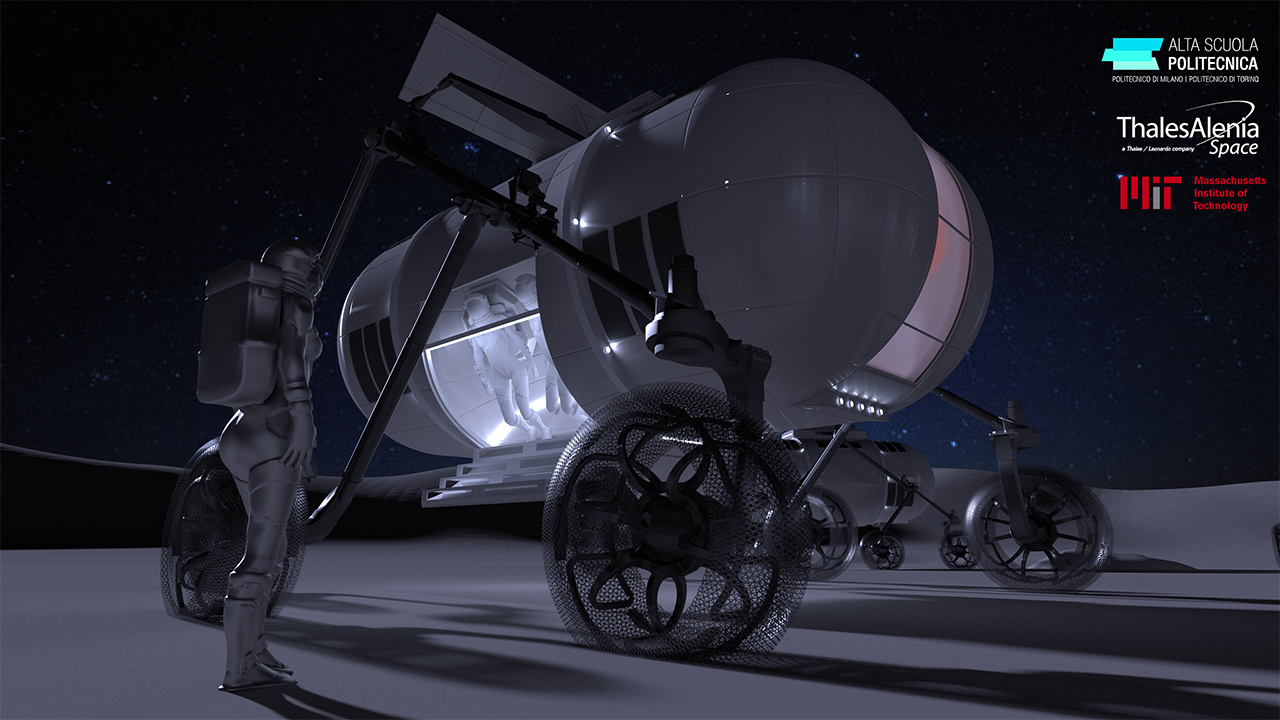
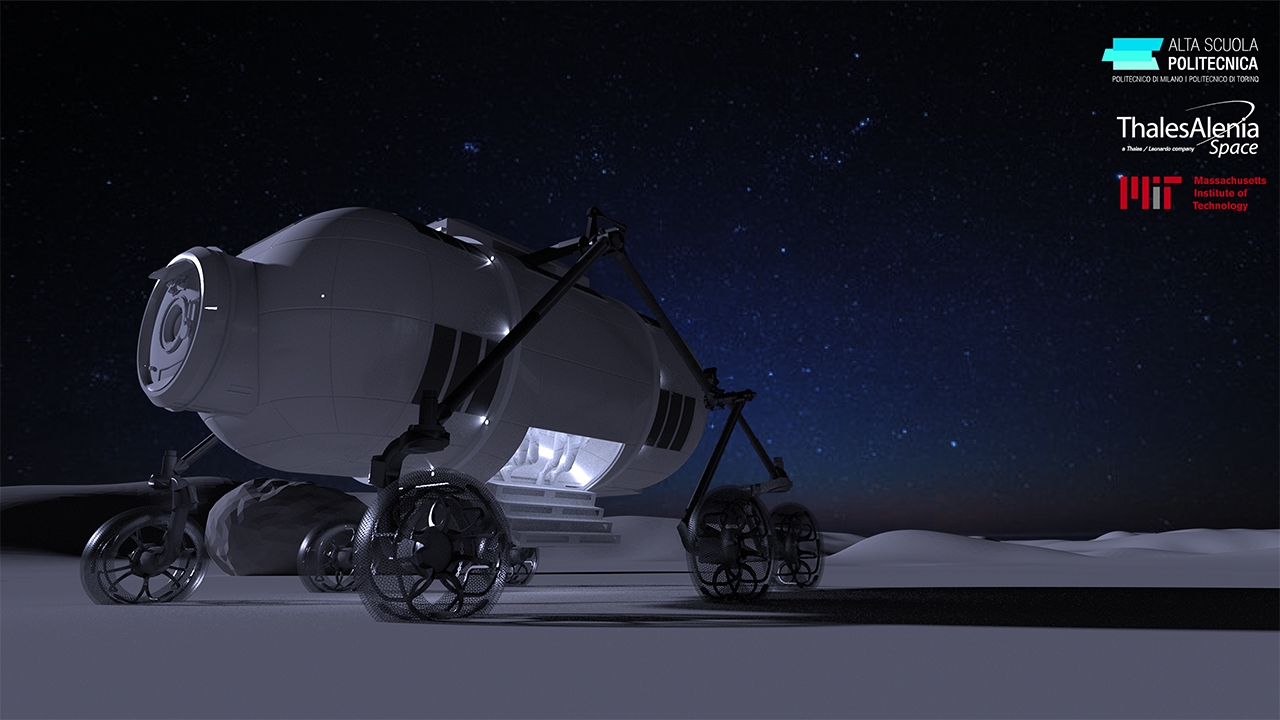
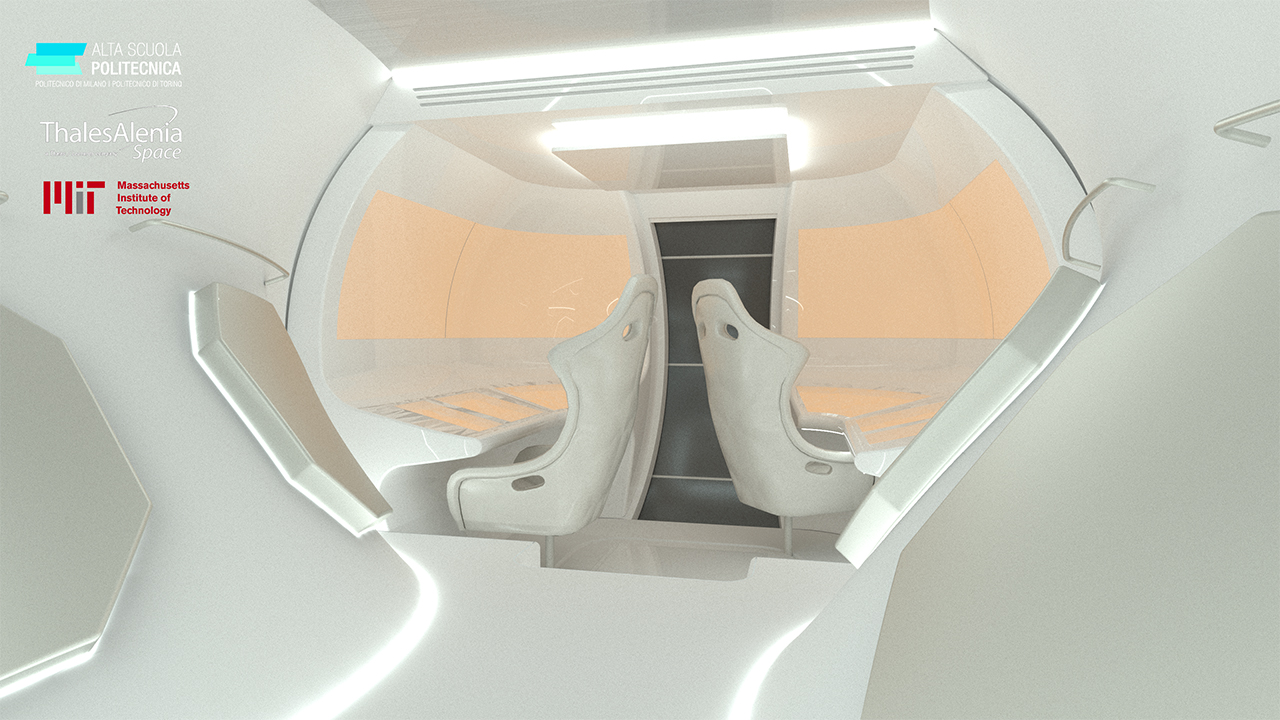
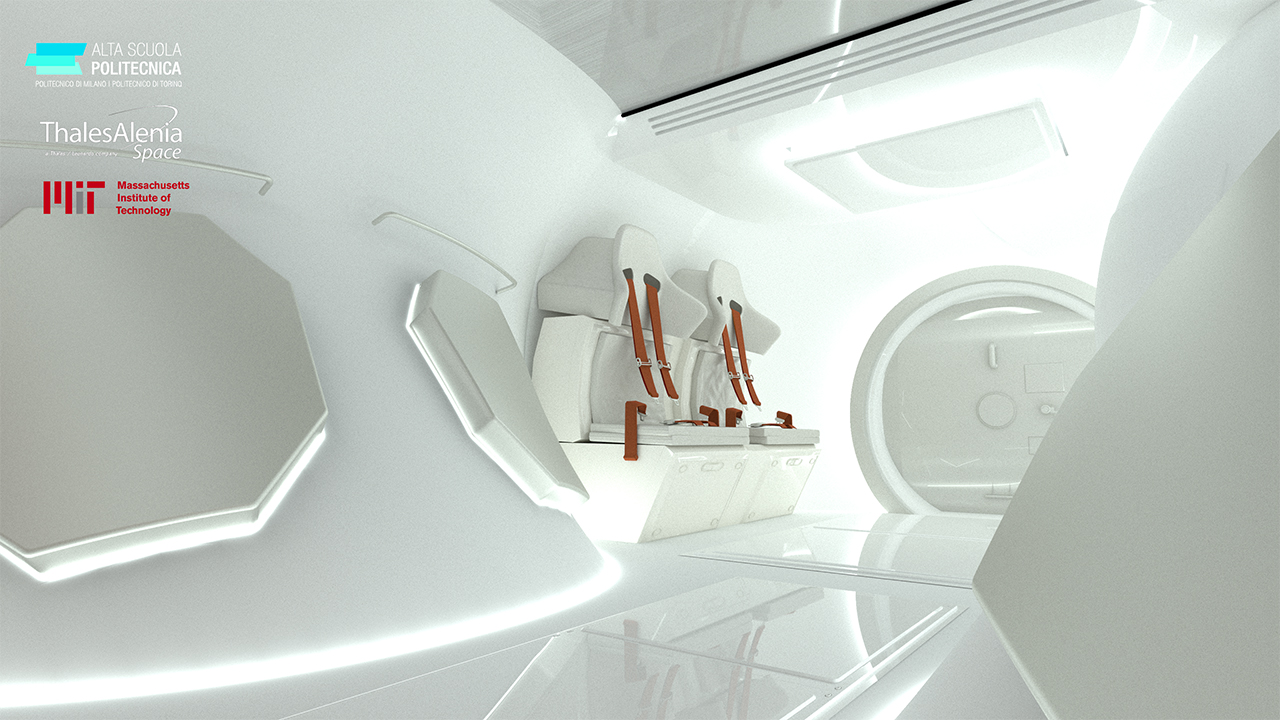
LADE positions itself in the initial phase of Moon exploration, human transportation, and technology exploitation for future applications, in the view of a permanent settlement on the lunar surface. To bring humankind successfully to the Moon, a mission framework must be defined. A preliminary research phase was carried out to identify needs and requirements to be fulfilled and to acquire knowledge of the state of the art in space module architecture. Being a mobile module, designers and engineers had to assure efficient mobility and proper speed for long-distance travel, according to the extreme lunar environment. Providing energy self-sufficiency over multiple conditions and shielding for different hazards has also been crucial in the conceptual phase. Moreover, functional needs, such as the crew’s psychological and physical well-being, were considered. Once the needs and requirements were assessed, several case studies were analyzed, comparing the pros and cons of different features, some of which played a determining role in defining the key elements of our project. As far as it concerns the concept idea, this project envisions different typologies of mobile pressurized modules supported by a network of permanent shelter providing protection and supply. The aim is to provide a range of typologies of mobile modules to choose from, according to the specific mission. The idea follows the “wagon train” concept and is based on the presence of a primary mobile module in charge of navigating and paving the way, followed through computer vision by the secondary modules selected for the mission (e.g., dedicated to research or storage).
LADE mobile modules can be combined through airlocks when stationary to create a joint pressurized space, thus creating a multi-module base through which astronauts can easily move across to perform their activities. This technology enables significant flexibility of the desired performances according to the missions.
Completed the phase 1 of research and first concept definition, the project went through a second phase of mission location and site analysis, an iterative phase to study and dimension the main subsystems of the primary module structure, locomotion, shielding, and power, and a final phase of interior design. A physical 3D mock-up was then realized through additive manufacturing. The study of the land morphology has been crucial to conduct a preliminary analysis of the mission location. For this purpose, the Grasshopper © software has been used to perform a slope analysis of the terrain, select possible landing points, and finally define the best trade-off strategy for the spatial distribution of the various mission trips. Given the limitations provided by the maximum slopes that can be sustained by the module and the maximum time that allows for energy autonomy and radiation protection (fixed to 6h), the best strategy resulted in a radial development of the mission, starting from the Shackleton crater (located at the Moon South Pole).
As to the module structure, the structural system for the primary module was organized based on the functional needs and the payload constraints. In particular, the system has been divided into two main macro-elements: the mobility system, and the shell structure, containing the pressurized habitat space. The latter was topologically optimized exploiting static computational analysis performed with Grasshopper© software, resulting in a finalized geometry of the shell.
Regarding the locomotion system, the requirements to be fulfilled were the first to be defined, followed by the choice of the best system among the existing possibilities. Once assessed the rocker-bogie was the most efficient solution, the system components were designed and dimensioned, particularly the wheels.
The shielding is an essential component of the module, responsible for preserving the astronauts’ safety by limiting the hazard due to radiations, micrometeoroids, and harsh temperature variations that characterize the Moon’s surface. To properly define and dimension it, different solutions from the literature and avant-garde materials were analyzed. Given the novelty of the materials chosen for the radiation shielding, a deeper analysis using NASA’s software OLTARIS© was performed to determine the safest thicknesses.
Once defined all the previous elements, a power subsystem able to provide for the energetic needs of the mobile module was dimensioned. Also in this case, different commercial possibilities were investigated, resulting finally in a combination of rechargeable batteries and photovoltaic panels.
The interior design and the internal functional configuration of the primary mobile module was defined by the main functions to be provided (navigation, suitports, life support systems, storage, waste management, etc.). The solution was found within a biophilic approach, as the functional distribution is inspired by the bee’s body: when connected, the modules resemble the head, the thorax, and the abdomen of the considered animal by their functions.
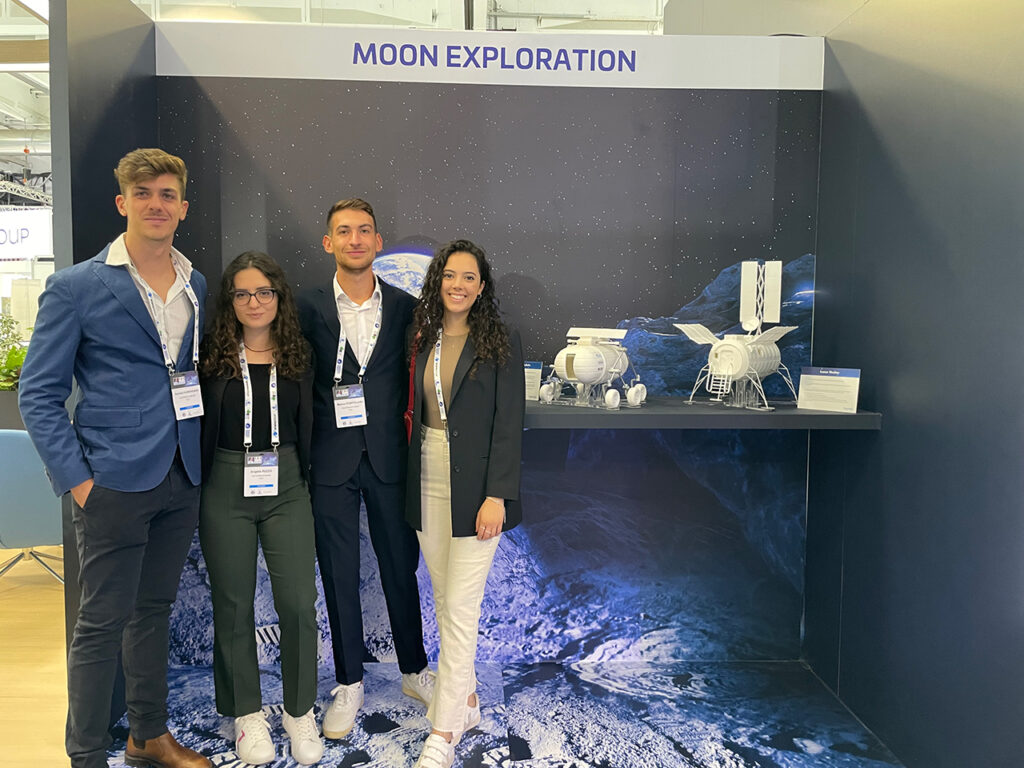
After the completion of the research and design activities, a physical mock-up was built through additive manufacturing, as a proof-of-concept of the project’s output. The mock-up has been developed through a process of digital fabrication design that has seen the virtual model transformed to be 3D printed in a detail scale of 1:20 through a process of laser sintering and subsequently refined to be presented at the conference.
LADE project, at least as far as it concerns the holistic methodology exploit to develop all the aspects related to the design of a habitable, efficient, and safe module for the exploration of the Moon’s surface, will serve as a starting point for future research and real outputs in this sector.
